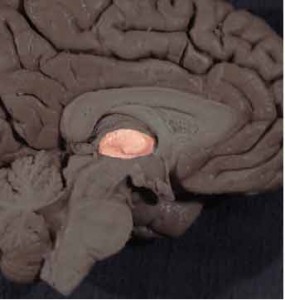A reader Mark asks this interesting question about central pain:
As one with thalamic pain syndrome, the result of a brain hemorrhage, I’ve been interested in the work of Ramachandran in treating phantom limb syndrome with a mirror box, because it essentially demonstrates the potential of re-interpretation of pain signals for those of us whose pain is generated entirely from brain damage.
My pain occurs throughout the left half of my body, which has lost tactile sensation. The pain is a facet of wrong signals generated by an injured right thalamus deep in my brain. I practice revisualizing its invalidity, its untruth. by making my pain-free right side the other side of Ramachandran’s famous mirror box in my imagination. I move both arms in unison, eyes closed, focusing on the healthy right, making it the reality and repeating to myself, This together, both arms, is the truth, it is the quality of armness. The right side teaches the left this sensory truth, not totally or all at once, but enough to help.
It also reduces fear and helplessness, two terrible facilitators of pain. I would be interested to know if any research is being done in treating central or thalamic pain management in ways that draw upon Ramachandran’s path-breaking work.
“Central pain” is pain that is generated from the brain itself. Thalamic strokes are a common cause of central pain, in which the thalamic area is damaged and pain is a symptom of this. My understanding of Ramachandran’s work is slightly different from what Mark says above. Mirror therapy is thought to work on the brain in these ways:
- re-integrating accurate perception of sensation
- correcting the sense that the brain has of where a body part is, even without looking
- correcting the accuracy and ease of how the brain directs movement of a body part
The way I think about mirror therapy is that you’re correcting other functions of the brain (sensation, movement) and as a side benefit, pain decreases when these other things get corrected. So in a sense, I don’t think that pain gets reinterpreted, as much as these other functions return closer to normal and fewer pain signals are generated as a result of this normalization.
If the visualization Mark is doing decreases pain, that’s great! I believe visualization is a beneficial technique. In addition to this, however, I think there are other ways people with central pain might be able to use brain re-training techniques such as mirror therapy. There has been significant work using mirrors to help with movement after stroke. However, as far as I’m aware, there haven’t been studies done using mirror therapy for central pain after stroke. It’s not clear brain re-training would work, but this is what I would consider:
1. Do actual mirror work (not just in the imagination), with the painful side (in Mark’s case, the left) hidden behind a mirror. If bilateral movement increases pain on the left, just do movements on the right side. While doing movement, watch the reflection of the right side in the mirror. So you’d be looking towards the left side; your actual left side is hidden behind the mirror, so you’re watching the reflection of your right side.
2. To re-train touch, you can try 2 things; first, touch different textures directly on the left while watching what you’re doing. This is without mirrors. Or with mirrors, again put the left side behind the mirror, and touch the right side, again watching the reflection in the mirror.
3. Lastly, focus on the left (painful) side when doing bilateral movement. However, don’t focus on the pain, but on the sensations of normal movement on the left. People already try to ignore their painful sides, so getting your brain “re-aquainted” with the left side is crucial to restoring normalcy.
Mark, thanks for your interesting question.


